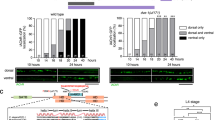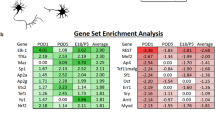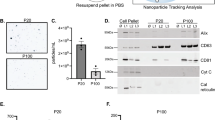Abstract
Until recently, the existence of extracellular kinase activity was questioned. Many proteins of the central nervous system are targeted, but it remains unknown whether, or how, extracellular phosphorylation influences brain development. Here we show that the tyrosine kinase vertebrate lonesome kinase (VLK), which is secreted by projecting retinal ganglion cells, phosphorylates the extracellular protein repulsive guidance molecule b (RGMb) in a dorsal–ventral descending gradient. Silencing of VLK or RGMb causes aberrant axonal branching and severe axon misguidance in the chick optic tectum. Mice harboring RGMb with a point mutation in the phosphorylation site also display aberrant axonal pathfinding. Mechanistic analyses show that VLK-mediated RGMb phosphorylation modulates Wnt3a activity by regulating LRP5 protein gradients. Thus, the secretion of VLK by projecting neurons provides crucial signals for the accurate formation of nervous system circuitry. The dramatic effect of VLK on RGMb and Wnt3a signaling implies that extracellular phosphorylation likely has broad and profound effects on brain development, function and disease.
This is a preview of subscription content, access via your institution
Access options
Access Nature and 54 other Nature Portfolio journals
Get Nature+, our best-value online-access subscription
$29.99 / 30 days
cancel any time
Subscribe to this journal
Receive 12 print issues and online access
$259.00 per year
only $21.58 per issue
Buy this article
- Purchase on Springer Link
- Instant access to full article PDF
Prices may be subject to local taxes which are calculated during checkout






Similar content being viewed by others
Data availability
The authors declare that all data supporting the findings of this study are available within the article and its supplementary information or from the authors upon reasonable request.
References
Hornbeck, P. V. et al. PhosphoSitePlus: a comprehensive resource for investigating the structure and function of experimentally determined post-translational modifications in man and mouse. Nucleic Acids Res. 40, D261–D270 (2012).
Bordoli, M. R. et al. A secreted tyrosine kinase acts in the extracellular environment. Cell 158, 1033–1044 (2014).
Samad, T. A. et al. DRAGON: a member of the repulsive guidance molecule-related family of neuronal- and muscle-expressed membrane proteins is regulated by DRG11 and has neuronal adhesive properties. J. Neurosci. 24, 2027–2036 (2004).
Samad, T. A. et al. DRAGON, a bone morphogenetic protein co-receptor. J. Biol. Chem. 280, 14122–14129 (2005).
Ma, C. H. et al. The BMP coreceptor RGMb promotes while the endogenous BMP antagonist noggin reduces neurite outgrowth and peripheral nerve regeneration by modulating BMP signaling. J. Neurosci. 31, 18391–18400 (2011).
Kam, J. W. et al. RGMB and neogenin control cell differentiation in the developing olfactory epithelium. Development 143, 1534–1546 (2016).
Cang, J. & Feldheim, D. A. Developmental mechanisms of topographic map formation and alignment. Annu. Rev. Neurosci. 36, 51–77 (2013).
Sperry, R. W. Chemoaffinity in the orderly growth of nerve fiber patterns and connections. Proc. Natl Acad. Sci. USA 50, 703–710 (1963).
Drescher, U. et al. In vitro guidance of retinal ganglion cell axons by RAGS, a 25 kDa tectal protein related to ligands for Eph receptor tyrosine kinases. Cell 82, 359–370 (1995).
Schmitt, A. M. et al. Wnt–Ryk signalling mediates medial-lateral retinotectal topographic mapping. Nature 439, 31–37 (2006).
Hindges, R., McLaughlin, T., Genoud, N., Henkemeyer, M. & O’Leary, D. EphB forward signaling controls directional branch extension and arborization required for dorsal–ventral retinotopic mapping. Neuron 35, 475–487 (2002).
Flanagan, J. G. Neural map specification by gradients. Curr. Opin. Neurobiol. 16, 59–66 (2006).
Cheng, H. J., Nakamoto, M., Bergemann, A. D. & Flanagan, J. G. Complementary gradients in expression and binding of ELF-1 and Mek4 in development of the topographic retinotectal projection map. Cell 82, 371–381 (1995).
Monnier, P. P. et al. RGM is a repulsive guidance molecule for retinal axons. Nature 419, 392–395 (2002).
Tessier-Lavigne, M. & Goodman, C. S. The molecular biology of axon guidance. Science 274, 1123–1133 (1996).
Tamagnone, L. et al. Plexins are a large family of receptors for transmembrane, secreted, and GPI-anchored semaphorins in vertebrates. Cell 99, 71–80 (1999).
Bonhoeffer, F. & Huf, J. Position-dependent properties of retinal axons and their growth cones. Nature 315, 409–410 (1985).
Hornberger, M. R. et al. Modulation of EphA receptor function by coexpressed ephrinA ligands on retinal ganglion cell axons. Neuron 22, 731–742 (1999).
Tassew, N. G. et al. Modifying lipid rafts promotes regeneration and functional recovery. Cell Rep. 8, 1146–1159 (2014).
Kalia, M. et al. Arf6-independent GPI-anchored protein-enriched early endosomal compartments fuse with sorting endosomes via a Rab5/phosphatidylinositol-3′-kinase-dependent machinery. Mol. Biol. Cell 17, 3689–3704 (2006).
Prevostel, C., Alice, V., Joubert, D. & Parker, P. J. Protein kinase Cα actively downregulates through caveolae-dependent traffic to an endosomal compartment. J. Cell Sci. 113, 2575–2584 (2000).
Shyng, S. L., Heuser, J. E. & Harris, D. A. A glycolipid-anchored prion protein is endocytosed via clathrin-coated pits. J. Cell Biol. 125, 1239–1250 (1994).
Cooper, A. & Shaul, Y. Clathrin-mediated endocytosis and lysosomal cleavage of hepatitis B virus capsid-like core particles. J. Biol. Chem. 281, 16563–16569 (2006).
Ding, Y. et al. Genome-wide analysis of dorsal and ventral transcriptomes of the Xenopus laevis gastrula. Dev. Biol. 426, 176–187 (2017).
Thakar, S., Chenaux, G. & Henkemeyer, M. Critical roles for EphB and ephrin-B bidirectional signalling in retinocollicular mapping. Nat. Commun. 2, 431 (2011).
Mao, B. et al. Kremen proteins are Dickkopf receptors that regulate Wnt/β-catenin signalling. Nature 417, 664–667 (2002).
Mao, J. et al. Low-density lipoprotein receptor-related protein-5 binds to Axin and regulates the canonical Wnt signaling pathway. Mol. Cell 7, 801–809 (2001).
Tamai, K. et al. LDL-receptor-related proteins in Wnt signal transduction. Nature 407, 530–535 (2000).
MacDonald, B. T. & He, X. Frizzled and LRP5/6 receptors for Wnt/β-catenin signaling. Cold Spring Harb. Perspect. Biol. 4, a007880 (2012).
Yamamoto, H., Sakane, H., Michiue, T. & Kikuchi, A. Wnt3a and Dkk1 regulate distinct internalization pathways of LRP6 to tune the activation of β-catenin signaling. Dev. Cell 15, 37–48 (2008).
Duchardt, F., Fotin-Mleczek, M., Schwarz, H., Fischer, R. & Brock, R. A comprehensive model for the cellular uptake of cationic cell-penetrating peptides. Traffic 8, 848–866 (2007).
Nusse, R. & Clevers, H. Wnt/β-catenin signaling, disease, and emerging therapeutic modalities. Cell 169, 985–999 (2017).
Zhu, W. et al. IGFBP-4 is an inhibitor of canonical Wnt signalling required for cardiogenesis. Nature 454, 345–349 (2008).
Harada, H., Takahashi, Y., Kawakami, K., Ogura, T. & Nakamura, H. Tracing retinal fiber trajectory with a method of transposon-mediated genomic integration in chick embryo. Dev. Growth Differ. 50, 697–702 (2008).
Funahashi, J. et al. Role of Pax-5 in the regulation of a mid-hindbrain organizer’s activity. Dev. Growth Differ. 41, 59–72 (1999).
Hamburger, V. & Hamilton, H. L. A series of normal stages in the development of the chick embryo. 1951. Dev. Dyn. 195, 231–272 (1992).
Sato, Y. et al. Stable integration and conditional expression of electroporated transgenes in chicken embryos. Dev. Biol. 305, 616–624 (2007).
Lê, S., Josse, J., & Husson, F. FactoMineR: an R package for multivariate snalysis. J. Stat. Softw. https://doi.org/10.18637/jss.v025.i01 (2008).
Savier, E. et al. A molecular mechanism for the topographic alignment of convergent neural maps. eLife 6, e20470 (2017).
Acknowledgements
This work was supported by the Krembil Foundation (P.P.M.), the Glaucoma Research Society of Canada (P.P.M.), the Heart and Stroke Foundation of Ontario (grant NA7067 to P.P.M.) and the Canadian Institutes for Health Research (grants MOP106666 and MOP-85014 to P.P.M.). We thank M. Whitman for the gift of the VLKKM mutant.
Author information
Authors and Affiliations
Contributions
H.H. performed the chick in vivo studies and biochemical experiments. N.F. carried out outgrowth experiments on dissociated RGCs. X.-F.W. and M.R. performed analysis and imaging of pathfinding in mice. R.B. and S.S. designed some of the constructs to generate CRISPR mice and expression plasmids. L.A. co-developed the in vitro system that allows electroporation in RGCs and study of cell-surface localization. J.-F.C. established the RGMb mouse model. M.M. performed MS on RGMb. J.C. performed in situ hybridization for RGMb. P.P.M. designed experiments and wrote the manuscript.
Corresponding author
Ethics declarations
Competing interests
The authors declare no competing interests.
Additional information
Publisher’s note: Springer Nature remains neutral with regard to jurisdictional claims in published maps and institutional affiliations.
Supplementary information
Supplementary Information
Supplementary Note 1 and Supplementary Figures 1–21
Rights and permissions
About this article
Cite this article
Harada, H., Farhani, N., Wang, XF. et al. Extracellular phosphorylation drives the formation of neuronal circuitry. Nat Chem Biol 15, 1035–1042 (2019). https://doi.org/10.1038/s41589-019-0345-z
Received:
Accepted:
Published:
Issue Date:
DOI: https://doi.org/10.1038/s41589-019-0345-z
This article is cited by
-
Mesenchyme-derived vertebrate lonesome kinase controls lung organogenesis by altering the matrisome
Cellular and Molecular Life Sciences (2023)
-
Extracellular phosphorylation in axon pathfinding
Nature Chemical Biology (2019)



